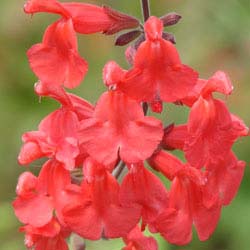New at FBTS: Vermilion Bluffs ® Mexican Sage

A 'mass of scarlet awesomeness' is one way that Denver Botanic Gardens Senior Curator Panayoti Kelaidis describes Vermilion Bluffs® Mexican Sage (Salvia darcyi 'Pscarl') at his Prairie Break website.
Unlike so many Southwestern sages, Vermilion Bluffs is surprisingly cold hardy as well as being drought tolerant. Its common name is taken from the spectacular red bluffs of the Vermillion Basin Wilderness (unlike the plant, it's spelled with two 'l's) in Northwestern Colorado, an area redolent with the scent of sage on hot days. But the plant is native to the Nuevo Leon area of Eastern Mexico's Sierra Madre Occidental mountain range.
Some sources spell the cultivar name with a double 'l'. However you spell it, you spell beauty.
A Salvia Diaspora
The story of how Vermilion Bluffs’ parent plant arrived at Denver Botanic Gardens (DBG) is one of diaspora. A plant explorer collects a species in its native land, cultivates the Salvia and gives starts to friends in many places -- even on other continents.
If the plant succeeds for the new owners, then it begins to proliferate in their local settings as the new owners share it with other gardeners. Then it may make its way into plant research and development and commercial nurseries.
So it was with the S. darcyi plant that Kelaidis received in the early 1990s when, he notes, the plant wasn't yet identified as a species. Texas plant explorers Carl Schoenfeld and John G. Fairey collected the original plant in Nuevo Leon and shared starts with North Carolina plantsman Richard Dufresne, known by his friends as the "Salvia Guru." Dufresne then gave starts to Kelaidis.
Kelaidis nurtured it in DBG's Rock Alpine Garden where he said it was "spectacular" but unreliably perennial. So he took regular cuttings each year to replace the plant when necessary. One day he discovered what appeared to be the same Salvia darcyii plant in a more open and unlikely spot for perennial success where some other DBG staff member had planted it. This particular planting seemed to thrive in one of DBG's most popular venues for weddings -- the wildly passionate Romantic Gardens. Kelaidis says he was surprised to discover its faithfulness in returning year after year.
As to how and when a seedling from the parent plant developed to became the Romantic Gardens cultivar, Kelaidis says, "The exact origins are lost in the mists of time."
Kelaidis, the Denver Botanic Gardens and Colorado State University's Plant Select program then worked together to test the Romantic Garden cultivar in trial gardens around the state.
Plant Select's Executive Director Pat Hayward says that one especially successful plant proved its hardihood on a golf course in Westminster, a northern suburb of Denver. However, Shaleen Hiller, horticultural specialist for the City of Westminster says she obtained cuttings for the golf course plant from the Denver Zoo in 2001. At that time, she recalls, the zoo's botanical staff thought the plant had come from Carl Schoenfeld's Yucca Do nursery in Texas.
Yet the zoo isn't far from the Botanic Gardens, which holds regular sales of plants created from its stock. It may be that the Salvia darcyi in question actually came from DBG through Plant Select or a DBG plant sale. When it comes to tracking a plant's lineage, you can find yourself traveling in foggy circles.
It was cuttings from the Westminster plant that Plant Select finally developed as Vermilion Bluffs and introduced to the commercial market in 2007. However, the bottom line is that the Romantic Gardens and Westminster plants are both still going strong.
High Altitude Hardihood
Salvia darcyi grows at altitudes of up to 9,000 feet in its homeland, a trait that destined it to do well on Colorado's high plains. Plant Select has rated Vermilion Bluffs as being perennial in USDA Zone 5b at altitudes up to 5,500 feet, which is slightly lower than Denver's mile-high elevation.
Hayward notes that only plants reproduced from parent plant cuttings have proven reliable in surviving harsh winter weather. That is what you can expect from Flowers by the Sea: sages true to Vermilion Bluffs' parent plant due to reproduction by cuttings.
Kelaidis, who is exhuberant in his love of the Salvia genus, calls Vermilion Bluffs "gaudily, ostentatiously, joyously red," and adds that it is a sort of "burning bush" of which Moses might have taken note.
Vermilion Bluffs is comfortable into Zone 9. It needs full sun and fertile, loamy, well-drained soil. You can expect it to reach heights of 36 to 48 inches with a spread of 36 inches.
Although it prefers regular watering, this hummingbird favorite is successful in dry gardens. Grow it in sunny shrub borders, containers, cut flower gardens and background plantings. It generally blooms from summer to fall, but Kelaidis has discovered this shrubby perennial blooming as early as April some years at DBG. Deadheading the blossoms increases bloom time.
Cold-Tolerant Sages
At Flowers by the Sea, we are expanding our variety of sages for Zone 5. These include a number of Turkish and European sages, many of which Kelaidis has tested for high altitude cold hardiness at DBG. Our other unusually cold-hardy sages include Salvia greggii varieties such as Cold Hardy Pink and Ultra Violet.
If you live in a region with winter chill and extreme summer heat, we have a number of choices for you. Please give us a call or write with any questions you may have. We're here to help make your garden more beautiful no matter where you live.

 Salvia verticillata
Salvia verticillata  Salvia greggii 'Cold Hardy Pink'
Salvia greggii 'Cold Hardy Pink'  Salvia darcyi 'Pscarl'
Salvia darcyi 'Pscarl'
Comments
There are no comments yet.